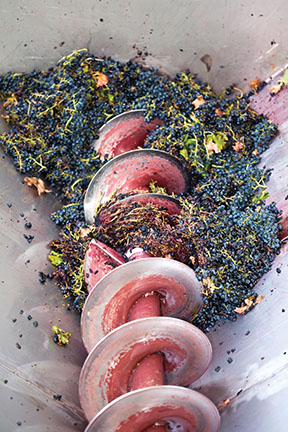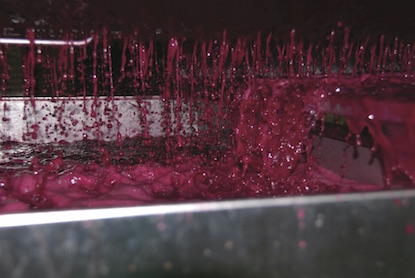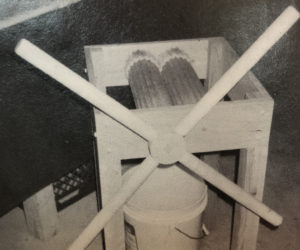 The first decision when making wine is whether or not to crush the grapes at all. When you make wine from fresh grapes, there are two basic techniques, one for white and one for red:
The first decision when making wine is whether or not to crush the grapes at all. When you make wine from fresh grapes, there are two basic techniques, one for white and one for red:
White: Crush, press, ferment
Red: Crush, ferment, press
From that backbone, though, many paths open. Steps can be rearranged or even skipped. Other steps will be added. Using this abbreviated sequence as a starting point, here are some other decisions and techniques about crushing.
Whole Cluster
This subject fits only as an exception in a column on crushing. For white wine, if you have access to a bladder press, you might just press whole clusters of white grapes directly to juice and then ferment that to make your wine. Most other presses, like the common ratcheting basket press, cannot exert enough force to effectively pop and flatten the grapes, so you will be back to one of the crushing techniques discussed later. For red wine, whole cluster fermentation is possible. In the special case of carbonic maceration, whole clusters are placed in a sealed (but vented) tank under a carbon dioxide atmosphere. Enzymatic fermentation proceeds to a moderate alcohol level and along the way it bursts and softens the grapes. They can then go directly to a press and finish like a white or rosé wine, sometimes with additional wine yeast added. Complete whole-cluster fermentation for conventional red wine is uncommon, mostly because all the stems are still in there and many contribute undesirable flavors, aromas, and astringency.
Crush by Foot
When you tell new friends you make wine at home, is the first question, “do you stomp the grapes?” I have heard that one many times, but I have never used the technique. Nonetheless, it has a long and storied history in winemaking. While the French term pigeage now usually refers to any manual punchdown, at one time it expressed the entire phrase pigeage à pied, meaning crushing (and punching down) by foot. While it is traditional and may even be fun, it has the same drawback for red wine as fermenting whole clusters: All the stems are still in there. You could certainly do it for whites, then transfer the must to the press where the stems will not interfere. Some Port producers have long used crushing by foot, noting that the gentle pressure of bare feet tends not to break the stems much, so minimizing release of “stemmy” character. And Port fermentations are pressed off after only partial fermentation, so there is less chance of developing off character from the stems. If you want to try it, wash your feet and legs just before entering the tank and avoid any lotions or perfumes.
Crush by hand
While this may sound as unlikely as crush by foot, it is actually quite feasible for a small lot, say 100 lbs. (45 kg) or less. You can even do this to achieve the separation of stems from the must and thereby simulate mechanical crushing and destemming. To do this, place an open-mesh grid made of non-reactive material over your fermenting bin. Rub the grape clusters on the grid, forcing the fruit through and leaving the stems on top. After each small batch, collect and discard the stems. Coarse stainless steel wire mesh is available on the Internet in 12” x 12” (30 x 30 cm) sheets for less than $20. I have also heard from people who say a plastic milk crate works very well, allowing the fruit to pass through the bottom grid while neatly retaining the stems. Whatever material you use, you may want to wear heavy rubber gloves to save your knuckles from being grated as well! For red wine, you now have destemmed must in the tank and you can proceed to make the wine. For white, you do not really need to destem, but it won’t hurt. Alternatively for white, you can squeeze each cluster in your hand over the press as you drop it in. Your hands will get very tired, but there is minimal equipment expense.
Manual grape Crusher
This is the entry point for crushing with conventional equipment. The “manual” in this case refers to the flywheel or hand crank on the side of the machine with an attached handle. You turn the crank and two rollers in a hopper pull the grape clusters down, break the skins, and allow the must (and stems) to fall through. Much, much faster than squeezing or rubbing by hand, manual crushers are available with hoppers made from wood, painted steel, or stainless steel. Crushing rollers, usually ribbed to grip the grapes, are most commonly made from aluminum. Rubber rollers are available on some machines and are said to be “more gentle” on the grapes, but let’s face it: You are crushing them. Prices range from about $200 for a crusher with a wooden hopper to $300 for a painted steel hopper and perhaps close to $400 for stainless steel. Many home winemaking shops rent manual crushers for about $20 per day. Once again, the stems are still in the must after crushing. No problem for white grapes going next to the press, but for reds you are left with the possible negative effects of the stems. For a small lot, you can dredge through the must with your hands, grabbing stems and lifting them out. Shake off juice and toss the stems aside. It is hard and slow work, but avoids the expense, bulk, and weight of crusher/destemmers described below.
Manual crusher/destemmer
If you get to this level, you have a machine that does both of the initial winemaking tasks for you: It breaks the grapes and it removes the stems. Sometimes casually called a stemmer/crusher, the distinction is important. While there are devices that destem before crushing, the manual crusher/destemmer crushes first, then removes stems. Some users, in pursuit of gentle handling, want to crush lightly or avoid crushing as much as possible, just destemming. The manual crusher/destemmer is not suitable for that purpose because the destemmer components are not sturdy enough to work on whole grape clusters. The machine includes a hopper and crank on top that is very similar to a manual crusher. As the grapes are crushed between the rollers, they fall into a metal box that contains a perforated grid and a crankshaft with paddles on it. These items, like the hopper and box, may be made of painted steel or stainless steel. The paddles are arranged in a spiral pattern so the turning of the crank acts like an Archimedes screw, pushing the stem clusters toward the far end of the machine as the must falls through to a bin or tank below. Meanwhile, at the end of the machine, a gap between the grid and the box allows the stems to fall into a separate bin or trash can.
Some machines are mounted on a stand with a sort of sheet metal funnel collecting the must and allowing for a smaller receiving bin. For larger lots, the machine may be placed across a half-ton (450 kg) bin, possibly supported on boards, with the stemmer end extended beyond the wall of the tank. Just lift the machine off and start fermenting! It will require a helper, as the units are about 4 feet (1.2 m) long and weigh about 70 lbs. (32 kg).
If the grapes you are processing are very mature and the stems are well lignified — brown and woody — the crusher/destemmer may break up some of them and allow them into the must. Since they are well browned, they will not likely introduce much “stemmy” green character. If the stems are green and flexible, the machine is very effective at removing them.
After a day of crushing, be sure to thoroughly clean your machine. The lid of the stemmer box comes off and the grate can be pulled out. Hose off all of these parts and pay special attention to the upper inside corners of the stem box — they will be caked with crushed must. You may need a long-handled brush to get all the debris off. Let everything air dry before reassembling, lightly oil chains and gears, and store in a dust-free area until next harvest.
These hand-crank machines sell for about $400 to $600 and rent for about $50 per day. If you do not live near a winemaking store that sells such equipment, shipping may be costly as the size typically dictates shipping by motor freight (on a pallet on a truck) rather than by UPS. I used a model like this with a stainless steel hopper for about 10 years and I was very happy with it. Eventually, fewer friends willing to turn the crank showed up on harvest day at my hobby vineyard and I invested in an electric model. I keep the manual unit on hand, though, as a backup and for teaching classes. It provides a real hands-on experience for new winemakers.
Electric crusher/destemmer
This machine is very much like the manual units just described, with the addition of an electric motor and drive belt in place of the hand-crank flywheel. Operation is simple with an “on” button and a large red “off” button so you can turn it off quickly if something (rock, wood) jams the rollers. Keep hands clear—it moves fast. A variety of configurations are available and most should easily process one to two tons an hour. Units start at about $750 and go up to perhaps $1,500 for an all-stainless steel model with rubber rollers. Again, clean thoroughly and lubricate after use. For these machines, there is the additional caution that you must not get the motor wet—they are not sealed. You may want to put a plastic bag over the motor as you hose off the machine. I now use an electric model of this kind and I like it even better than my trusty old manual model. Once again, it will require a helper to move around, as they weigh about 125 lbs. (57 kg). I support mine on galvanized steel saw horses, sliding 32-gal. (120-L) bins in and out as needed. Purpose-built stands are also available.
Electric stemmer
This is the high end of “crushing” grapes, although it may not have an actual crusher. In any case, the grapes first enter a chamber with a very heavy-duty version of the paddle arrangement in a crusher/destemmer. The paddles and shaft are strong enough to tear the grapes off the stems of whole clusters. Depending on configuration, the must falls through to different setups. It may simply drop out the bottom, as with a crusher/destemmer. It may fall through crushing rollers, making the machine truly a stemmer/crusher rather than the other way around. The most advanced models feature a must pump in the bottom, where the must is forced out through a hose and can be directed right to the fermentation bin. Even though such a destemmer does not “crush,” in my experience the pump itself turns the must into sort of a grape purée. That said, it is certainly very handy that you can simply point the hose at a bin, pitchfork grapes into the machine, and have destemmed must put right where you want it. Various models cost between $2,000 and $6,000 and truck shipping is required.







